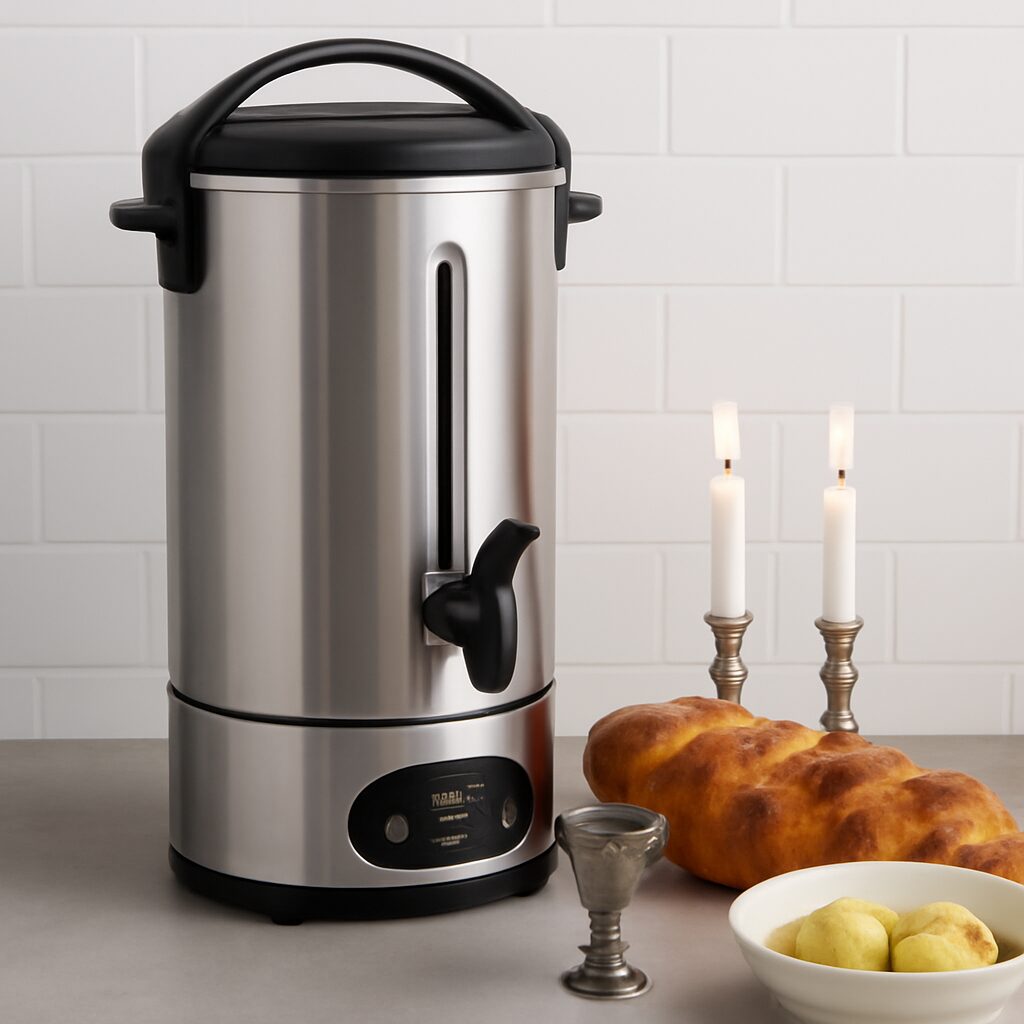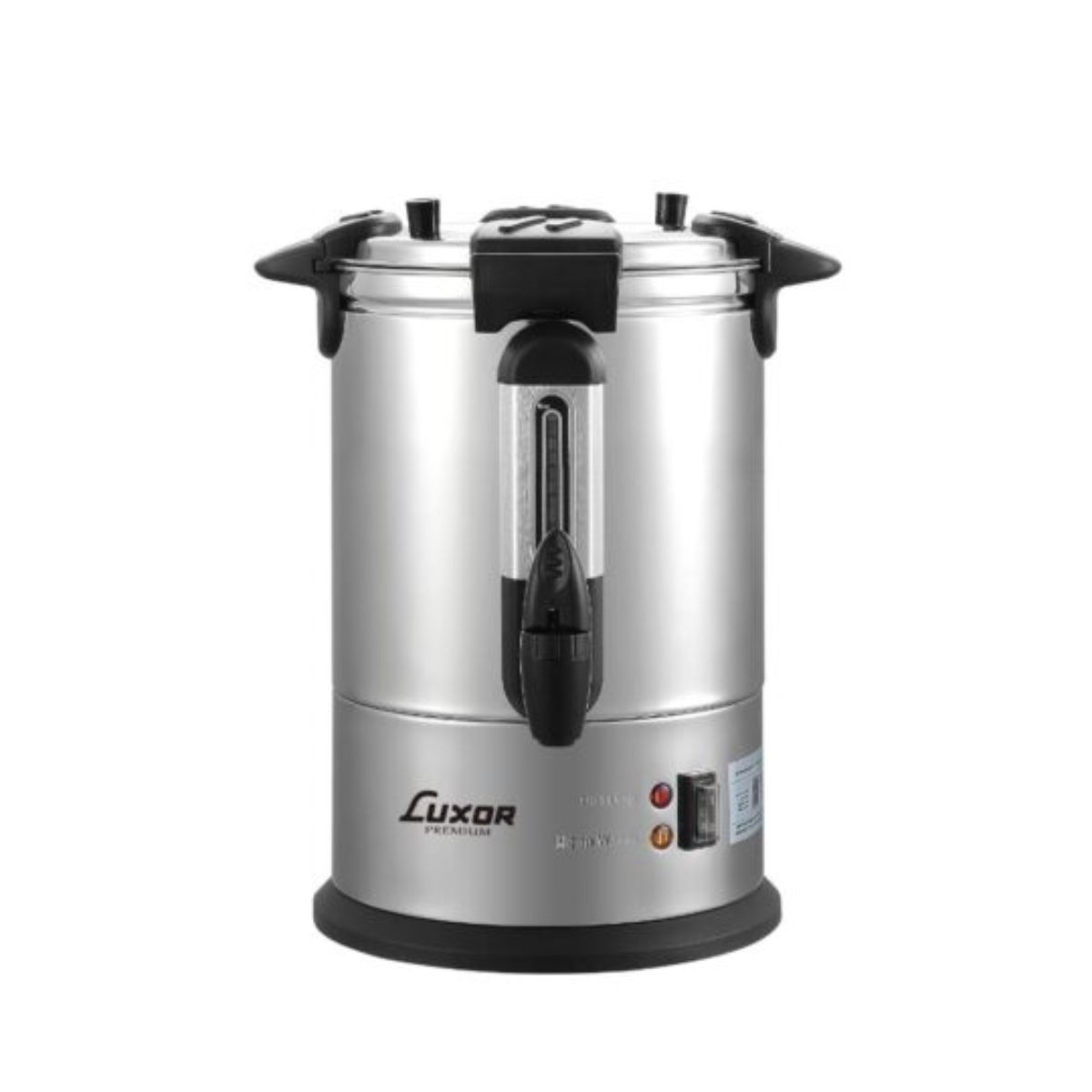
A Shabbat kettle, also known as a Shabbat urn, is a specialized vessel designed to keep water hot for extended periods without violating Shabbat laws. It typically features insulation or a heating mechanism that operates before Shabbat begins. This allows observant Jews to have access to warm water for tea, coffee, or other uses throughout the day of rest.
A Shabbat kettle (also called a Shabbat urn or hot water urn) is designed to provide hot water on Shabbat while complying with Jewish law (halacha). Here’s how it works both mechanically and halachically:
Mechanically
- Constant Heating
- The kettle has a heating element that keeps the water at a steady temperature (usually below boiling, around 85–90°C / 185–194°F).
- It does not turn on or off automatically based on temperature changes during Shabbat.
- No Thermostat Activation
- Regular electric kettles have thermostats that turn the heating element on and off when the water cools.
- Many Shabbat kettles disable this feature so that opening the spout or adding water won’t trigger electricity.
- Manual Water Dispensing
- Some urns use a pump system or gravity-fed spout to pour water. This avoids using an electric pump that might be activated when dispensing.

Halachically
1. Cooking (Bishul)
- Boiling water is considered cooking (which is prohibited).
- The urn is filled and turned on before Shabbat so no cooking happens on Shabbat itself.
- The water stays hot but does not cook anything further.
2. Adding Water (Shehiya and Chazara)
- Some models allow adding pre-heated water, but this must be done carefully to avoid violating cooking laws.
- Some authorities say adding even warm water to a hot urn is forbidden.
3. Electricity (Molid and Grama)
- A regular electric kettle turns on and off automatically, which is a problem on Shabbat.
- A Shabbat kettle has a setting that keeps the heat constant to avoid activating electricity.
- Some models use a Shabbat mode that ensures any electrical changes happen indirectly (grama).
4. Pouring Hot Water (Mechzi K’mevashel)
- Pouring from the urn into a cup is usually allowed, as long as the cup is not used to cook additional items.
- Some halachic authorities require pouring into an intermediate cup first (kli sheni) to avoid concerns of cooking.

- The kettle is filled and heated before Shabbat.
- The heat stays constant without activating switches or thermostats.
- Water can be dispensed manually without triggering electricity or cooking violations.
- Some models allow adding water but only under specific conditions.
Frequently Asked Questions (FAQ)
Typically, Shabbat kettles are not intended for keeping food warm, as they are designed for hot water specifically. Using a dedicated warming tray or similar device for food is preferred, ensuring adherence to halachic guidelines regarding food preparation and heating on Shabbat.
No, a Shabbat kettle is specifically designed to keep water hot for drinking and other non-cooking purposes. Cooking on Shabbat is generally prohibited, and using a Shabbat kettle adheres to halachic guidelines by providing hot water without violating the laws of Bishul.
It is advisable to fill the Shabbat kettle with sufficient water before Shabbat begins to avoid the need to add water or adjust the kettle during Shabbat, which could potentially violate halachic restrictions.
Shabbat kettles are designed primarily for water. While boiling water is permitted, adding other ingredients or liquids that can cook (like tea or instant soup) is not generally recommended, as this may lead to a situation where you might inadvertently be cooking on Shabbat.
No, adjusting temperature settings or manipulating any controls on the kettle during Shabbat is not permitted, as it may violate the prohibition on operating electrical devices. It is important to set the kettle properly before Shabbat starts.
Frequently Asked Questions
What is a Shabbat kettle or Shabbat urn?
A Shabbat kettle or Shabbat urn is a special insulated container used in Jewish homes to keep water hot for making tea, coffee, or other hot drinks on Shabbat (the Jewish Sabbath) when cooking and using electrical appliances are prohibited.
Why do Jewish people use a Shabbat kettle?
Jewish law prohibits cooking and using electricity on Shabbat. A Shabbat kettle allows observant Jews to have access to hot water throughout the day without violating these restrictions, as the water is heated before Shabbat begins and kept warm in the insulated container.
How does a Shabbat kettle work?
A Shabbat kettle works by being filled with boiling water before Shabbat begins. Its thick insulation and tight seal maintain the water's heat for many hours. Some models have a tap or spout for easy pouring without opening the container, which would release heat.
What's the difference between a Shabbat kettle and regular thermos?
While both keep liquids hot, Shabbat kettles are specifically designed for Jewish law requirements. They often have larger capacities (2-5 liters), better insulation for 24+ hours, and features like a tap or spout to avoid 'cooking' by adding hot water to a cup (which might be prohibited).
Can you use a Shabbat kettle for anything besides water?
While primarily used for water, some people use Shabbat urns to keep soups or stews warm. However, this requires careful planning as food must be fully cooked before Shabbat begins and the urn must be designated for either liquids or foods (not alternated).

